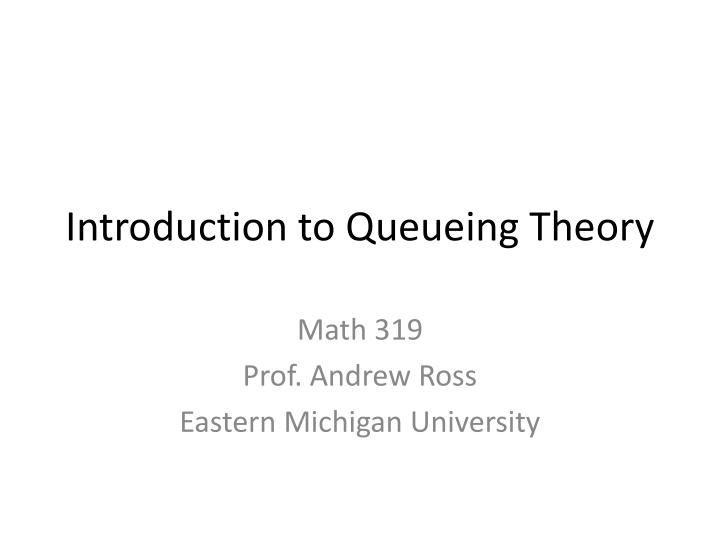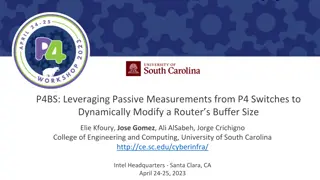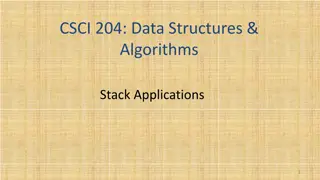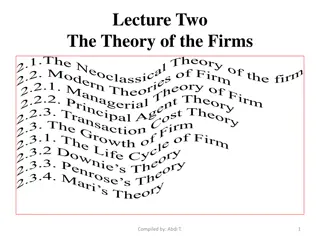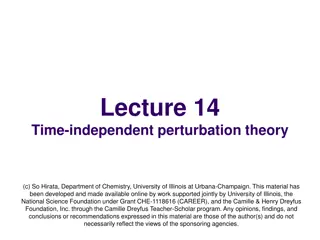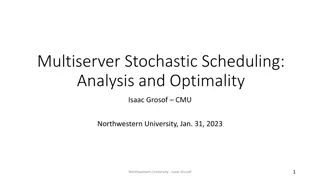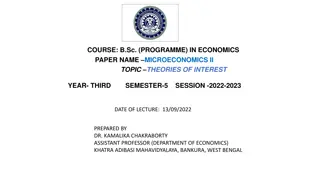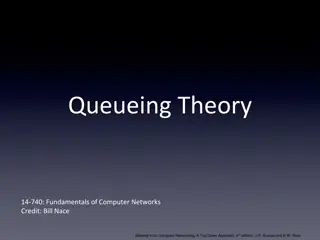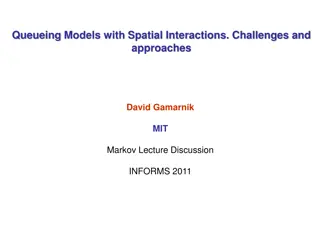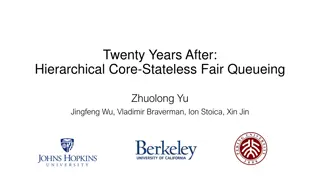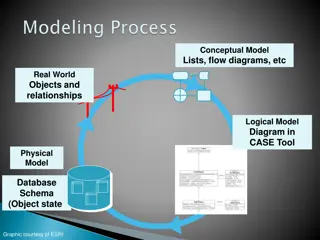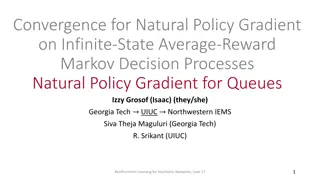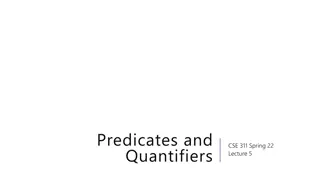Queueing Theory: Applications and Notations
Queueing theory is a mathematical study focused on predicting wait times and server configuration in systems with queues, such as telephone call centers, factories, and air travel. This theory helps in optimizing service levels and resource allocation to minimize waiting times and enhance efficiency.
Download Presentation

Please find below an Image/Link to download the presentation.
The content on the website is provided AS IS for your information and personal use only. It may not be sold, licensed, or shared on other websites without obtaining consent from the author.If you encounter any issues during the download, it is possible that the publisher has removed the file from their server.
You are allowed to download the files provided on this website for personal or commercial use, subject to the condition that they are used lawfully. All files are the property of their respective owners.
The content on the website is provided AS IS for your information and personal use only. It may not be sold, licensed, or shared on other websites without obtaining consent from the author.
E N D
Presentation Transcript
Introduction to Queueing Theory Math 319 Prof. Andrew Ross Eastern Michigan University
What is Queueing Theory? A queue = a line of people or things waiting to be served Queueing Theory: ways of predicting how long the line or the wait will be, or deciding on how many servers to have Some people spell it queuing rather than queueing; either is acceptable (I prefer queueing)
Applications Telephone call centers Factories Inventory Health Care Police/Firefighter/Ambulance Repair technicians Car/Truck traffic Internet data traffic UPS/FedEx Machines waiting for repair Restaurants Etc.
Air Travel Wait to find a parking space Wait for the parking shuttle Wait to check your bags Wait to get through security Wait to buy some food Wait for your plane to arrive Wait to board the plane Wait for luggage to finish loading Wait to de-ice Wait to take off Wait to de-ice Wait to take off Wait for the peanuts Wait to land Wait for the gate to free up Wait to de-plane Wait for your luggage Wait for a taxi
Intuition Check Suppose a company gets 40 calls/hour to its receptionist, who can handle 50 calls/hour on average Mean # calls in the system will be 4 Sketch a graph with x=time, y=#calls in system when mean # in system is 4 people.
Start Simple: Ignoring Time-of-day changes in arrival rate Job priorities Balking (giving up before joining the queue) Abandoning/reneging (giving up while in queue) Retrials (trying back later after balking/abandoning) Batch Arrivals Batch Service Uncertainty in arrival rate Bilingual/Monolingual Servers (Press 1 for English ) Virtual Hold (Press 1 and we will call you back)
Notation: Input Measures lambda = arrival rate, e.g. 120 calls/hour, or 1 every 30 seconds on avg. mu = service rate per server, e.g. 4 calls/hour = 15 minutes per call, on avg. c = # of servers (or k, or m, or n, or s) rho = lambda/mu = traffic e.g. rho=120 calls/hour / 4 calls/hour = 30 (unitless)
Notation: Output Measures L = avg # of people or jobs in the system That s in the line plus those in service Lq = avg # of people or jobs in the queue Not including those in service W = avg time spent in the system by a job that s time spent in line, plus time spent in service Wq = avg time spent in the line Of course, W = Wq + 1/mu
Standard Problems Knowing lambda, mu, and c, what will the average waiting time or line length be? There are some exact formulas, but not always Knowing lambda and mu, and having a limit on the avg. waiting time, how many servers are needed? There is a simple approximate formula for this, but hardly ever an exact formula.
Basic Output Measures: when? For queues involving people, we usually care about Wq, because once they get into service, they are happy. At the emergency room, you want to see a doctor right away, but once you do, you don't want that doctor to rush. For queues involving objects, we usually care about W, because as long as they are in the system, they aren't being used profitably elsewhere. Less common to care about L or Lq only when deciding how big the waiting area should be. And even then, need to plan for much more than the average.
Fancy Output Measures % of time that a server is busy ( utilization ) Higher is good to keep costs low Lower is good to keep waiting times low Overall, don't try to control it, except: Keep it under 95% (?) for human servers Pr(wait < 20 seconds) = 80% (?) Adapt to context: Emergency 911 vs IRS helpline Pr(had to wait at all) % Abandonment Pr(blocked) if there's a finite waiting room
Little's Law L = lambda*W, and Lq = lambda*Wq Along with W=Wq+1/mu Given any one of L, Lq, W, Wq, you can compute the other 3 easily. But Little's Law doesn't actually compute any of them in the first place. Also applies to infinite-server systems where Wq=0, W=1/mu. Also applies just to servers: avg # in service = arr. rate to service * 1/mu
The Main Formula: Setup Single-server system. Technical name: M/M/1 Arrivals are random according to a Poisson Process (Math 360/Math 419) If you put down a dot on a timeline each time a call arrives, it looks like this: Not at all evenly spaced! Lots of gaps and clusters. Service times: distribution is exponential. Standard Deviation of service times is roughly equal to the mean service time. Histogram looks like this:
The Main Formula Recall: rho = traffic = lambda/mu L = rho/(1-rho) Doesn t depend on lambda or mu separately, just their ratio. Calculate in your head: rho L 0.5 0.8 0.9 0.99
Make a spreadsheet & graph L = rho/(1-rho) for an M/M/1 queue Use: rho=0, 0.25, 0.5, 0.75, 0.9, 0.99 Use markers-with-connecting-straight lines Now try markers-with-connecting-smooth-lines Why are the smooth lines bad? If rho=0.99 and you spend 10% more money to make the server go 10% faster, now rho=0.9 What % does L decrease?
Multi-Server as single-server? Original System Fast Single Server lambda=5 calls per minute Talk time avg: 10 minutes/call: mu = 1/10 k=57 servers. Erlang-C calculator gives: lambda=5 calls per minute Talk time avg: 10/57 min/call: mu=57/10, k=1 server M/M/1: rho=50/57, Wq=(1/mu)*rho/(1-rho)= Wq = 75 seconds Pr(not delayed)=1-rho=12% Wq=21.1 seconds Pr(not delayed) = 75.35% Is it a good idea to approximate multi-server with a fast single server calculation?
Single vs Multi-Server Single-server intuition still applies: as rho gets large, L&W go to infinity But the avg wait & avg # aren't the same for single vs multi-server. Also: Single-server: most people are in the queue Multi-server: most people are in service
3 Laws of Applied Queueing Theory 1. Get there before the queue forms 2. At the grocery store, stay to the far left or right (but not at tollbooths) 3. For M/M/c, you need approximately #servers = rho + z*sqrt(rho) z=1:good service Technically, z is the Normal Distribution cutoff for Pr(not delayed). For example, if Pr(not delayed)=85%, then z=1 z=2:great service
Practice with the 3rd Law Also called Square-root staffing If rho=10, you need 10+1*sqrt(10)=13.16 or 14 servers, which is 31% more than rho alone. If rho=100, you need... Which is ??% more than rho alone. If rho=1000, you need... Which is ??% more than rho alone
More on efficiency I stopped here at traffic=400, but biggest physical call centers are about 2000 people (can get bigger by virtual grouping) Old hospital guideline: aim for 85% utilization. Bad! Infomercial operators are standing by ? They are consolidated & cross-trained. In 1978 there were 661 Poison Control Centers in the US, now there are 51, with a national 1-800 number
Except for Data Networks Arrival of data packets isn't even a renewal process, let alone a Poisson Process Shows fractal patterns! Usually, averaging over a longer timespan reduces variability, but not for data networks. Where Mathematics Meets the Internet Walter Willinger and Vern Paxson
Service Ordering First-Come-First-Serve (FCFS) or FIFO Last-Come-First-Serve (LCFS) or LIFO Service in Random Order (SIRO) or RSS All of these have same averages (L, Lq, W, Wq) FCFS has lowest wait-time variance, LCFS highest
Service Ordering: lower mean wait! Shortest Job First needs estimate of service time for each job Shortest Remaining Processing Time Also needs ability to interrupt jobs But either can really slow down long jobs. Round-Robin Each job gets a little slice of time, e.g. 5ms-30ms
Appointment-based queueing E.g. dentist's office, doctor's office No-shows are a problem: forgetfulness, etc. Some clinics with low-income customers see high no- shows, will triple-book appointment slots! Car breakdowns, Can't get time off, Can't get a babysitter Much less academic work done on this. A tiny trend toward only making same-day appointments: Advanced Access
Time-of-Day arrivals? Improving the SIPP Approach for Staffing Service Systems That Have Cyclic Demands. Linda V. Green, Peter J. Kolesar and Jo o Soares. Operations Research, Vol. 49, No. 4 (Jul. - Aug., 2001), pp. 549-564 For call center models, if rho/mu < 1, can break it into hour-long segments and treat each independently. If it's any worse, hire a queueing theorist. Procedure: Forecast the arrival rate curve Decide how many servers in each time block Decide how many people on each shift (watch out for lunch breaks, coffee breaks, etc), scheduling (Math 560) Decide which people work which shift ( rostering )
Software Erlang-C calculators on the web & for Excel QTS Plus Discrete-Event Simulation: Arena, SIMUL8, GPSS, etc. http://www.lionhrtpub.com/orms/surveys/Simulation /Simulation1.html Can hack multiserver queues in excel: http://www.informs.org/Pubs/ITE/Archive/Volume- 7/Simpler-Spreadsheet-Simulation-of-Multi-Server- Queues
Bigger Issues If you add servers to improve service, fewer people will balk/abandon, and your servers might get busier. Game Theory where is the equilibrium?
